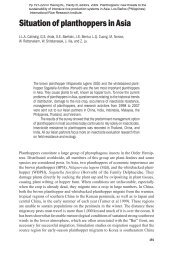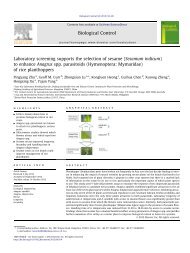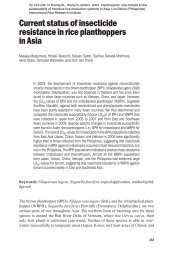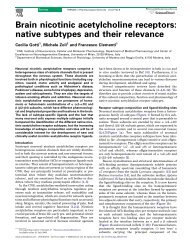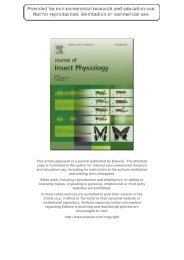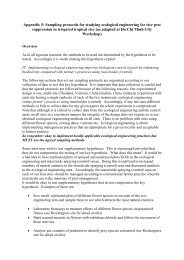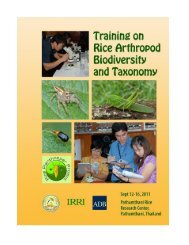Fujita, D. et al. 2009. The genetics of host-plant ... - Ricehoppers
Fujita, D. et al. 2009. The genetics of host-plant ... - Ricehoppers
Fujita, D. et al. 2009. The genetics of host-plant ... - Ricehoppers
- No tags were found...
Create successful ePaper yourself
Turn your PDF publications into a flip-book with our unique Google optimized e-Paper software.
Pp 389-400 IN Heong KL, Hardy B, editors. <strong>2009.</strong> Planthoppers: new threats to thesustainability <strong>of</strong> intensive rice production systems in Asia. Los Baños (Philippines):Internation<strong>al</strong> Rice Research Institute.Materi<strong>al</strong>s and m<strong>et</strong>hodsPlant materi<strong>al</strong>sEight rice cultivars with different levels <strong>of</strong> resistance to BPH—ADR52, Podiwi A8,Mudgo, ASD7, Rathu Heenati, Babawee, B<strong>al</strong>amawee, and Taichung 65 (T65) (noresistance gene)—were used. Near-isogenic lines derived from the GRH-resistantcultivar DV85 and IRGC105715, and BPH-resistant cultivar ADR52, were used.Insect strainsIn 2006, ten populations <strong>of</strong> BPH were collected in East Asia. Four populations werecollected from the Red River Delta (RRD1, RRD2) in northern Vi<strong>et</strong>nam and theMekong River Delta (MRD1, MRD2) in southern Vi<strong>et</strong>nam. Three populations werecollected from the Philippines: Northern and Centr<strong>al</strong> Luzon islands (LZ1, LZ2) andMindanao Island (MD). Single populations from Japan (JPN), China (CHI), and Taiwan(TW) were <strong>al</strong>so collected. <strong>The</strong>se populations were maintained by continuous rearingon susceptible cultivar Reiho at 25 ± 1 °C under 16 h light and 8 h dark conditions inthe laboratory <strong>of</strong> the Pest Management System, Nation<strong>al</strong> Agricultur<strong>al</strong> Research Centerfor Kyushu-Okinawa Region, Kumamoto, Japan. A GRH population was collectedin Fukuoka Prefecture in 1991 and was maintained by continuous rearing <strong>of</strong> insectson seedlings <strong>of</strong> japonica vari<strong>et</strong>y Nipponbare. Insects were kept at 25 ± 1 °C and 16h light, 8 h dark.Ev<strong>al</strong>uation <strong>of</strong> resistance to BPH and GRH<strong>The</strong> month-old <strong>plant</strong>s were trimmed and covered with a transparent plastic cylindric<strong>al</strong>cage (5.5 cm d × 20 cm h). Five brachypterous (short-wing form) BPH fem<strong>al</strong>eswithin 24 h after emergence were released to a cage and the open end was coveredwith gauze. A score was obtained starting from 3 days after infestation (DAI) to 5DAI. <strong>The</strong> adult surviv<strong>al</strong> rates as well as the fem<strong>al</strong>e abdomen were examined. Weev<strong>al</strong>uated the fem<strong>al</strong>es whose abdomens became heavily swollen or survived for 5days as virulent. <strong>The</strong> classification <strong>of</strong> virulent and avirulent BPH fem<strong>al</strong>es followedthe m<strong>et</strong>hod <strong>of</strong> Tanaka (2000). <strong>The</strong> experiment was carried out with 8 replications. <strong>The</strong>GRH antibiosis test was reported by Kishino and Ando (1978), and was modified foruse in our study. Seedlings were infested with 7–10 first- or second-instar nymphs intest tubes approximately 2 weeks after sowing. Nymph mort<strong>al</strong>ity was then c<strong>al</strong>culatedat 4 days after infestation. Plants with nymph mort<strong>al</strong>ity in the range <strong>of</strong> 0–40% werecategorized as susceptible, and those with 60–100% nymph mort<strong>al</strong>ity were categorizedas resistant.Statistic<strong>al</strong> an<strong>al</strong>ysis<strong>The</strong> data were an<strong>al</strong>yzed using two-way ANOVA. Treatment means were pair-wisecompared using the Turkey HSD test (SAS Institute Inc. 2002). <strong>The</strong> surviv<strong>al</strong> rate (%)was arcsine transformed prior to the an<strong>al</strong>ysis.<strong>The</strong> gen<strong>et</strong>ics <strong>of</strong> <strong>host</strong>-<strong>plant</strong> resistance to rice <strong>plant</strong>hopper and leafhopper 391



